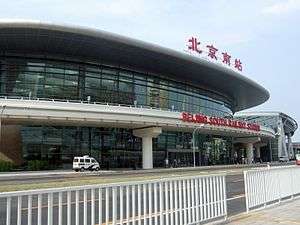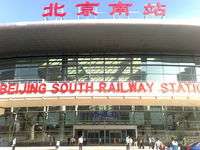Beijing South Railway Station
 Beijing South Station | |||||||||||||||||||||||||
| Other names | Beijing South | ||||||||||||||||||||||||
| Location |
Yongdingmen Chezhan Lu, Fengtai District, Beijing China | ||||||||||||||||||||||||
| Coordinates | 39°51′57″N 116°22′35″E / 39.86583°N 116.37639°ECoordinates: 39°51′57″N 116°22′35″E / 39.86583°N 116.37639°E | ||||||||||||||||||||||||
| Operated by | |||||||||||||||||||||||||
| Line(s) | |||||||||||||||||||||||||
| Platforms | 24 (11 island platforms, 2 side platforms) | ||||||||||||||||||||||||
| Connections |
| ||||||||||||||||||||||||
| Other information | |||||||||||||||||||||||||
| Station code | 1 | ||||||||||||||||||||||||
| History | |||||||||||||||||||||||||
| Opened | 1897 | ||||||||||||||||||||||||
| Previous names | Majiapu Station, Yongdingmen | ||||||||||||||||||||||||
| Services | |||||||||||||||||||||||||
| |||||||||||||||||||||||||
Beijing South (Beijingnan) Railway Station (Chinese: 北京南站; pinyin: Běijīngnán Zhàn) is a large railway station (mainly serving high speed trains) in Fengtai District, Beijing, about 7.5 km (4.7 mi) south of central Beijing, between the 2nd and 3rd ring roads. The station in its present form opened on 1 August 2008 and replaced the old Beijing South station, originally known as Majiapu Railway Station, later renamed Yongdingmen Railway Station, which stood 500 metres away. The old station was in use from 1897 to 2006.[1]
The new Beijing South Railway Station is the city's largest station, and is the one of the largest in Asia. It joins the main Beijing Railway Station and the Beijing West Railway Station as one of three main passenger rail hubs in the Chinese capital.[2] It serves as the terminus for high-speed trains on the Beijing–Tianjin Intercity Rail and the Beijing-Shanghai High-Speed Railway, which can reach speeds up to 350 km/h (217 mph).[3] Some CRH night sleepers to and from Shanghai also depart from (or arrive at) this station.
The station integrates two Beijing Subway line stations, bus hubs (including an airport shuttle bus), and taxi stands, into the same building, and includes a wide variety of restaurants in the station itself.
Design and construction
The terminus occupies a 32-hectare (79-acre) site in Fengtai.[4]
The enormous oval-shaped station was designed by the British architecture firm of TFP Farrells in collaboration with the Tianjin Design Institute.[5] It was built from more than 60,000 tons of steel and 490,000 cubic metres (17,304,000 cu ft) of concrete by 4,000 workers in less than three years. The glass ceiling is outfitted with 3,246 solar panels to generate electricity. The structure spreads out like a ray or trilobite and covers 320,000 square metres (3,444,000 sq ft), more than the Beijing National Stadium's 258,000 square metres (2,777,000 sq ft).[2] Its 24 platforms have the capacity to dispatch 30,000 passengers per hour or almost 241 million a year.[6] The 251,000-square-metre (2,702,000 sq ft) waiting area can accommodate 10,000 passengers.
On the elevated departures concourse, there are designated waiting areas and VIP lounges (with better seating and, in the lounges, free food and snacks) for passengers travelling in CRH Business Class, and a number of restaurants and corner shops. There are also a number of ticket counters (where nationwide ticketing services are available) and an increasing number of retail stores and fast food stalls. Ticket machines are available to holders of the PRC ID card and sell tickets for trains departing from this station. 23 sets of ticket gates despatch passengers onto trains.
The arrivals level is underground, with 8 arrival gates situated in the immediate vicinity of the Beijing Subway station concourse. To the sides are two taxi stands, and separated West and East parking lots for private cars (including a mezzanine level). Express entrances have been built, and are presently in use for all C trains to Tianjin, as well as some trains to Shanghai. Ticket machines and a few ticket counters are also available at the arrivals level. As with the departures level, a variety of restaurants and corner shops are also available at the arrivals level. Two floors below the arrivals level are the platforms for Lines 4 and 14, respectively, with Line 4 services available at present, and Line 14 services coming later in 2015.
Reconstruction began on 10 May 2006,[7] immediately after services ended at the old station. The station was complete for the 1 August 2008 reopening. In 2011 and 2012, new restaurants, fast food stalls, and corner shops were added. To cut queues, traditional counters at the arrival level were replaced with ticket machines.
Local transportation
The entire transportation system is integrated with the station itself.
- Beijing Subway: Beijing South Railway Station - Line 4, line 14.
- Beijing Bus stops:
- Beijing South Railway Station (北京南站): 381 458
- Beijing South Railway Station North Square (北京南站北广场): 20 84 102 106 203 458
- Beijing South Railway Station South Square (北京南站南广场): 72 208 529 652 665 特5 特8
- Beijing Airport Bus: Route 10
Bus routes in bold have a terminus at the stop.
The central and northern sections Line 14 services currently terminate at this station (December 2015). The western section of Line 14 ends at Xiju station pending completion of the west-central section of Line 14 to Beijing South Railway Station.
Trains
As of 2012, Beijing South Station is the terminal for two CRH railway lines. The Beijing–Tianjin Intercity Railway has frequent service to Tianjin (C trains). The Beijing–Shanghai High-Speed Railway runs G and D trains to Ji'nan, Nanjing, and Shanghai, with several trains continuing to Hangzhou and Ningbo, and one (G55) to Fuzhou. This railway also has services to Qingdao (via the Jiao'ao–Jinan branch)[8] and Hefei (via the Bengbu–Hefei branch).[9][10] Since July 2013, travel time to Hangzhou has been cut by one hour for direct services that skip Shanghai.
Beijing South services the world's third fastest train (after the Shanghai Airport Express Train and some faster trains of the Shinkansen).
Gallery
-

South Station full view
-

South Entrance (Outside)
-

South Entrance (Inside)
-

Waiting Area
-
CRH high-speed train
-
Beijing South Railway Station B1
Notes
- ↑ "Farewell, centenary Beijing South Railway Station", People's Daily May 12, 2006
- 1 2 "South station on track to impress" People's Daily Online July 24, 2008
- ↑ Patil, Reshma, "Aboard the Beijing Bullet, lessons for Delhi" Hindustan Times Archived February 21, 2009, at the Wayback Machine. Aug. 3, 2008
- ↑
- ↑ "Beijing South Station" tfpfarrells.com accessed Aug. 4, 2008
- ↑ Spring, Martin "The best china: 10 of the most spectacular new Chinese buildings" Building July 4, 2008.
- ↑ "Beijing South Railway Station Reconstruction Project Near Completion". Getty Images. 25 December 2007. Retrieved 12 June 2015 – via HighBeam Research. (subscription required (help)).
- ↑ 北京南列车时刻表 Archived September 6, 2012, at the Wayback Machine. (Beijing South trains schedule) (Chinese)
- ↑ G263次列车开通 坐高铁去合肥仅需4小时
- ↑ Hefei-Bengbu Passenger Special Railway Sells Tickets Today 2012-10-11
External links
- Beijing South Railway Station Guide
- Official site
- Photos of the reconstruction 2007-2008
- Beijing Train Time Table & Rail Transportation Guide